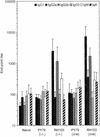Bacterial spores as vaccine vehicles
- PMID: 12704155
- PMCID: PMC153275
- DOI: 10.1128/IAI.71.5.2810-2818.2003
Bacterial spores as vaccine vehicles
Abstract
For the first time, bacterial spores have been evaluated as vaccine vehicles. Bacillus subtilis spores displaying the tetanus toxin fragment C (TTFC) antigen were used for oral and intranasal immunization and were shown to generate mucosal and systemic responses in a murine model. TTFC-specific immunoglobulin G titers in serum (determined by enzyme-linked immunosorbent assay) reached significant levels 33 days after oral dosing, while responses against the spore coat proteins were relatively low. Tetanus antitoxin levels were sufficient to protect against an otherwise lethal challenge of tetanus toxin (20 50% lethal doses). The robustness and long-term storage properties of bacterial spores, coupled with simplified genetic manipulation and cost-effective manufacturing, make them particularly attractive vehicles for oral and intranasal vaccination.
Figures





References
-
- Challacombe, S. J. 1983. Salivary antibodies and systemic tolerance in mice after oral immunisation with bacterial antigens. Ann. N. Y. Acad. Sci. 409:177-192. - PubMed
-
- Chatfield, S. N., I. G. Charles, A. J. Makoff, M. D. Oxer, G. Dougan, D. Pickard, D. E. Slater, and N. F. Fairweather. 1992. Use of the nirB promoter to direct the stable expression of heterologous antigens in Salmonella oral vaccine strains: development of a single-dose oral tetanus vaccine. Bio/Technology 10:888-892. - PubMed
Publication types
MeSH terms
Substances
LinkOut - more resources
Full Text Sources
Other Literature Sources

